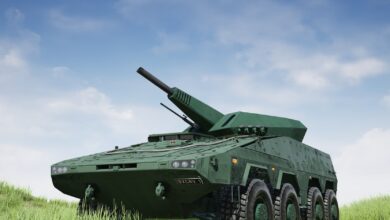Two new Boeing CH-47F (I) Chinooks for the IAF Arrive at the Indian shores

New Delhi. Boeing announced July 8, arrival of two more CH-47F (I) Chinooks for the Indian Air Force (IAF) at the Mundra port in Gujarat. Earlier this year on February 10, Boeing delivered the first four of the 15 Chinooks on order, which were inducted by the IAF on March 25, 2019. The new machines, after getting a thorough technical once over would be ferried to Chandigarh to augment the already four on strength of No. 126 Unit HU (Helicopter Unit – a smaller version of a full-fledged squadron).
To redux, IAF had contracted for 15 Chinooks with some Indian specifications from Boeing in 2015 for $1.1 billion with an option clause for another seven within the existing contract.
Hitherto, the huge Mi-26 helicopters acquired from the erstwhile Soviet Union in 1986, had been executing the heavy-lift tasks to the forward bases admirably well but their service life has long been over. IAF had acquired four of these machines and they indeed served the IAF for myriad tasks including for other services and civilian agencies, achieving many milestones in the bargain. This author for example, distinctly remembers a sortie conducted in 1987 from Leh, when flying the gigantic Mi-26 from the co-pilots seat, an Army One-tonner and a Jonga was soft landed for the first time in the far away Aksai Chin post of DBO (Daulat Beg Oldie) at a height of 16,500 ft, complete with the vehicle crews and enough POL barrels to last the garrison there for more than a month.
Notably, Mi-26 could carry a payload of 20 tonnes, not only inside its cavernous cabin but also, under-slung from a single point under its belly, generally matching in terms of payload with the four-engined An-12 transport aircraft. However, this capability existed only at sea level increasingly deteriorating at higher altitudes, with a ball-park reduction of one tonne for every thousand feet gain in height. No wonder, though an admirable feat in the DBO sortie, the actual pay-load did not
exceed five tonnes.
In comparison, even though smaller than Mi-26 and limited to 12 tonnes payload at sea level, Chinooks are much more advanced machines with the capability of carrying greater loads to high-altitude forward bases, thanks to their contra-rotating rotors which provide them phenomenal agility in the rough, mountainous Himalayan terrain. India has the unique requirement of rotary-wing operations due to its troubled borders in J&K and the vast Tibetan border in the north and north-east.
According to an IAF statement, “The helicopter has a fully integrated digital cockpit management system, advanced cargo handling capabilities, and Electronic Warfare suite that complements the aircraft’s performance. The helicopter is capable of airlifting diverse military and non-military loads into remote locations and war zones with remarkable survivability.”
As is well known, the Indian Army has already acquired the BAE M777 howitzers from the US, and a major task for the Chinook would be to ferry this gun underslung and in one piece to the required areas and posts. Needless to say this newly acquired capability would be a boon to the recently raised 17 Mountain Strike Corps in the furtherance of its offensive plans.
The Indian variant is designated Chinook CH-47F (I) and as expected, has been given first to the very same unit No. 126 HU which operated Mi-26s and will now be replacing them with Chinooks. However, as more helicopters arrive in India, IAF has plans to raise another Chinook unit to be based at Dinjan in the far east of India, close to Arunachal Pradesh, overlooking the Chinese Tibetan border in the region.
According to Boeing, the arrival of the two Chinooks is in-line with the planned delivery schedule, as well as Boeing’s commitment to ensuring the modernisation. Boeing also stated that other CH-47F(I) Chinooks will also continue to be delivered as per schedule.





